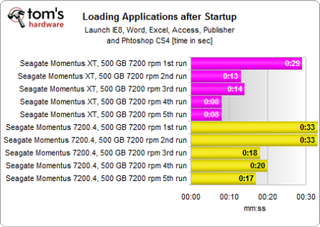Momentus XT Review: Seagate's Marriage Of The HDD And Flash Memory
Update: with more real-world testing under our belts, Seagate's Momentus XT is receiving our rare Best of Tom's award for excellent performance. This new hybrid hard drive combines up to 500GB of storage and 4GB of flash memory to maximize performance.
Benchmark Results: Windows And Application Startup Time

This first startup test is based on a fresh install of Windows 7 Ultimate x32 and all necessary drivers and a few applications. We decided to start Windows 7, Internet Explorer 8 with an offline instance of the Tom’s Hardware front page, and Photoshop CS4. The benchmark starts at the moment in which the system asks whether it should boot from a CD that we left in the optical drive. We negate the answer and take the time by noting an exact timestamp. Once our batch file has terminated it writes a second time stamp onto the drive. The time difference is what we put into the chart.
We’re learning two things: Momentus XT is faster than the Momentus 7200.4 in any run, and performance increases even on the conventional Momentus 7200.4. This is because Windows 7 has its SuperFetch feature, which also caches frequently-used application data.

Then we did the exact same thing, but this time using an existing and overloaded Windows Vista installation. Many people might be running such a system, hence we believe that this is a great real-life scenario. In this case, the Momentus XT maintains its impressive performance, while the Momentus 7200.4 doesn’t improve much over time. Clearly, the new Seagate hybrid drive does its job really well.

Last but not least, we added the time required to launch a few popular applications to our testing update. We launch Internet Explorer 8, MS Word 2007, MS Excel 2007, MS Access 2007 and MS Powerpoint 2007 (in this order) and take the time for this process. Seagate’s Momentus XT cuts the time from 29 seconds to 8 seconds on the fourth run, but already the second run (after a reboot) takes only 13 seconds. If you look at the comparison results using the Momentus 7200.4, you can clearly see just how much of a difference the hybrid drive makes. This isn’t possible by just accelerating rotating storage.
Stay on the Cutting Edge
Join the experts who read Tom's Hardware for the inside track on enthusiast PC tech news — and have for over 25 years. We'll send breaking news and in-depth reviews of CPUs, GPUs, AI, maker hardware and more straight to your inbox.
Current page: Benchmark Results: Windows And Application Startup Time
Prev Page Benchmark Results: PCMark Vantage, Repeated Next Page ConclusionMost Popular

